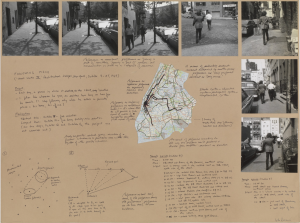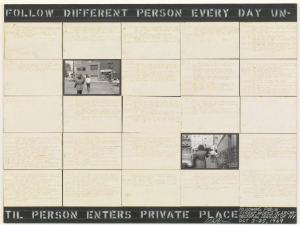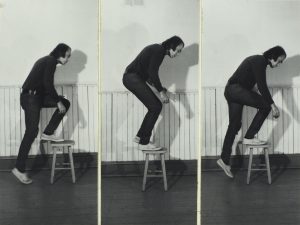Vito Acconci
Vito Acconci (1940, New York, United States – 2017, New York, United States) was an American artist based in New York who had a wide-ranging career in performance art, conceptual art, installations, video, poetry, and architecture. He is perhaps best known for his provocative works involving his body as a medium, such as the controversial Seedbed (1972), in which Acconci masturbated under a temporary floor and spoke of sexual fantasies into a microphone which was dispersed on speakers throughout the gallery.
Acconci was born in the Bronx to an Italian family. Acconci stated in an interview that his father, an immigrant from Italy, was a formative figure in his life because of his interest in music, literature, and art. Acconci became interested in all art forms at an early age, deciding at the age of five that he was to become a writer. He earned a bachelor’s degree in 1962 before earning a master’s degree in writing from the University of Iowa in 1964. He then returned to New York after graduate school to teach before switching to poetry. Although he was trained as a writer, he soon found the structures of language limiting.
Inspired by the works of Jasper Johns, he became inspired by the formal representation of a concept and was curious about physically interactive forms of expression. Despite having no formal training as an artist and therefore could not paint, sculpt or draw, he decided that he could partake in conceptual art, which was an emerging term in the mid-1960s.
In the 1960s, Acconci became co-editor of the journal, 0 to 9, which brought together leading artists in the conceptual art movement and contemporary writers such as Sol Lewitt and Robert Barry. He then began making his own artwork in the late 1960s. Early works such as Following Piece (1969) began to explore themes of private/public life and voyeurism. Works such as this led into his later explorations of human relations in other mediums.
Acconci then began an exploration of the physical and mental boundaries of the body in pieces such as Trademarks (1970), in which he bit parts of his body so hard that physical scars were left over. In other works, he explored sexuality and power such as in Openings (1970), in which Acconci pulled out the hairs around his navel.
In Acconci’s later works, he began to employ architectural elements in his installation works such as Extra Spheres for Klapper Hall (1993-1995) and Murinsel (Mur Island) (2003).
Throughout his life, he taught as an art lecturer at universities such as Brooklyn College, Cooper Union, and Parsons School of Design, Pratt Institute, and Yale University. He lived in New York until his death in 2017.
Selected Exhibitions
Vito Acconci. FAULT-LINE-ON-5, Pace Gallery, London UK (2019); Vito Acconci: Where We Are Now (Who Are We Anyway?) 1976, MoMA PS1, New York US (2016); Vito Acconci: Now and Then, Grieder Contemporary, Zurich CH (2014); Dark Places, Santa Monica Museum of Art, Santa Monica US (2006); Vito Hannibal Acconci Studio, Museu d´Art Contemporani de Barcelona – MACBA, Barcelona (2004); Vito Acconci: Acts of Architecture, Contemporary Arts Museum, Houston, Houston, TX (2001); New Work/Vito Acconci, James Corcoran Gallery, Los Angeles US (1990); Barbara Gladstone Gallery, New York US (1989); Vito Acconci, Museum of Modern Art, New York US (1988); Museum of Contemporary Art, San Diego US (1987); The Kitchen, New York US (1976, 1978, 1980, 1981); Stedelijk Museum, Amsterdam NL (1978); Whitney Museum of American Art, New York US (1978); Museum of Conceptual Art, San Francisco US (1975); Sonnabend, New York US (1972); Rhode Island School of Design, Providence US (1969).
Interested in Vito Acconci’s work?


